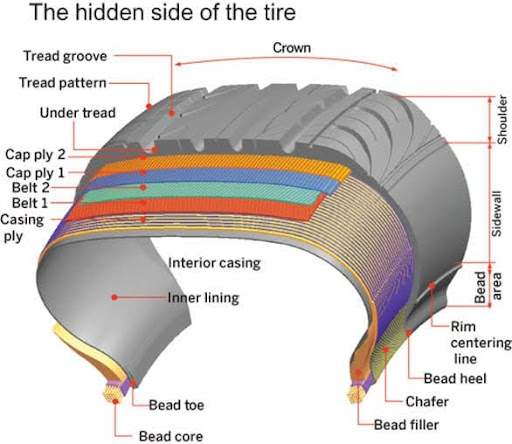Tire News & Information
Free shipping
Best price guarantee
Special pricing
Financing with Resolve
Easy returns

Tires are the unsung heroes of the automotive world, playing a crucial role in vehicle performance, safety, and comfort. While most drivers focus on factors like tread pattern and tire size when selecting new tires, there's another critical aspect that often goes overlooked: tire compounds.
Tire compounds refer to the specific blend of materials used to create the various components of a tire, particularly the tread. These carefully engineered mixtures of rubber, polymers, and additives work together to determine a tire's key performance characteristics.
Understanding the composition and impact of different tire compounds can help you make informed decisions when purchasing new tires, ensuring you select options that align with your driving needs and preferences. In this article, we'll dive deep into the world of tire compounds, exploring how these material blends influence tire performance and longevity.
What Are Tire Compounds?

Tire compounds are the secret recipes behind every tire on the market. These complex formulations consist of a precise blend of natural and synthetic rubbers, combined with an array of additives, fillers, and reinforcing agents. The specific composition of a tire compound is meticulously engineered to optimize key performance attributes:
- Traction: The ability of a tire to grip the road surface, especially in challenging conditions like wet or snowy weather
- Tread wear: The rate at which a tire's tread depth diminishes over time and mileage
- Rolling resistance: The amount of energy required to keep the tire rolling, which directly impacts fuel efficiency
- Ride comfort: The tire's ability to absorb road irregularities and provide a smooth, quiet ride
Tire manufacturers invest heavily in research and development to create compounds that strike the perfect balance between these often-competing characteristics. The goal is to design tires that offer reliable traction and handling, long tread life, and a comfortable ride, all while minimizing rolling resistance to improve fuel economy.
In general, tire compounds fall along a spectrum from harder to softer. Harder compounds typically prioritize durability and tread life, making them a popular choice for long-lasting all-season tires. Softer compounds, on the other hand, offer superior traction and grip, especially in colder temperatures—a key attribute of winter tires and high-performance summer tires.
However, the relationship between compound hardness and performance is not always straightforward. Advancements in materials science and tire engineering have led to the development of innovative compounds that challenge traditional trade-offs. For example, some modern all-season tires feature adaptive compounds that maintain pliability in cold weather for improved traction, while still offering excellent tread life.
As you explore the world of tire compounds, keep in mind that the ideal blend of materials will depend on your specific vehicle, driving habits, and local climate. Working with a knowledgeable tire professional, such as the experts at SimpleTire, can help you navigate the complex landscape of tire compounds and find the perfect match for your needs.
In the following sections, we'll take a closer look at the key components that make up tire compounds and how they influence tire performance. By understanding the role of rubber, polymers, fillers, and other additives, you'll be better equipped to select tires that deliver the right balance of traction, durability, and comfort for your vehicle.
Rubber and Polymers: Building Blocks of Tire Compounds
At the heart of tire engineering lies a sophisticated mix of materials designed to deliver specific performance attributes. High-performance tires rely on a blend of advanced polymers to achieve their superior capabilities. These polymers, engineered for durability and flexibility, ensure that tires can handle the demands of various driving conditions—from the scorching heat of summer roads to the slick surfaces of winter.
Natural rubber offers remarkable elasticity, making it ideal for maintaining traction across different terrains. However, its vulnerability to wear and heat necessitates the inclusion of synthetic alternatives. Styrene-butadiene rubber (SBR) is a common choice, known for its ability to withstand the rigors of road friction and temperature fluctuations. The precise balance between these materials is crucial—more natural rubber enhances grip, while a higher proportion of synthetic rubber contributes to prolonged tread life.
In the realm of tire innovation, specialized polymers are tailored to push the boundaries of conventional performance limits. These materials are meticulously crafted to adapt to extreme conditions, offering a balance of pliability and strength. By fine-tuning the composition of these compounds, manufacturers can produce tires that excel in specific temperature ranges, ensuring a reliable and safe driving experience regardless of the season. This careful engineering of rubber compounds defines the unique performance qualities inherent in each tire, providing drivers with an optimized ride tailored to their specific needs.
The Role of Fillers in Tire Compounds
Fillers are essential in enhancing a tire's performance by fine-tuning its properties. Carbon black is a standout filler, providing strength and resilience to the tire's structure. This material not only reinforces the rubber but also offers protection against ultraviolet exposure, which can cause the rubber to degrade. By absorbing UV rays, carbon black helps maintain the tire’s durability and extend its lifespan, making it a staple in tire manufacturing.
Silica serves as another critical filler with a distinct contribution: improving traction on wet surfaces. Derived from sand, silica enhances the tire's grip by keeping the rubber pliable, even in cold and wet conditions. This flexibility is crucial for maintaining safety, allowing the tire to adapt to the road's surface and providing a more secure driving experience. Silica also plays a role in reducing rolling resistance, which translates into better fuel efficiency—an increasingly important feature for modern drivers.
The precise formulation and balance of these fillers are vital in meeting diverse performance needs. Engineers carefully calibrate the ratio of fillers to achieve the desired characteristics in a tire. For instance, tires intended for high-speed travel may incorporate more carbon black for added durability, while those designed for wet climates might prioritize silica to enhance grip. This meticulous engineering results in tires that offer a blend of traction, longevity, and efficiency, tailored to meet the specific demands of different driving environments.
How Tire Compounds Impact Traction and Durability
The delicate balance between traction and durability in tire design depends significantly on the compounds used in their construction. Tires with softer compounds, enriched with natural rubber and advanced polymers, enhance road grip under challenging conditions. This heightened traction becomes particularly crucial in colder climates, where flexible materials maintain a steadfast grip on icy or wet roads, ensuring safety and control.
Despite their traction benefits, softer compounds may face quicker degradation in hotter environments. As temperatures rise, the compounds can soften further, leading to increased wear and a shorter lifespan. This heightened wear rate can be a critical consideration for those driving in warmer climates or engaging in high-speed travel, where heat intensifies the wear process.
In contrast, tires with harder compounds focus on longevity, integrating more reinforcing fillers like carbon black to withstand extensive use. Such compounds excel in longevity, making them a preferred choice for tires designed for extended journeys. Although this durability comes with a slight reduction in grip, particularly on slick surfaces, it suits drivers prioritizing longevity over peak performance. High-performance tires, especially, use specially formulated compounds to achieve a balance, offering superb grip while maintaining durability for varied driving needs.
Advancements in Tire Compound Technology
In the world of tire development, continuous innovation leads to compounds that set new benchmarks for performance. Recent advances in silica technology have revolutionized the way tires handle wet and snowy surfaces. These cutting-edge compounds enhance the tire's grip by maintaining flexibility and adhesion without diminishing tread life, crucial for ensuring dependable performance in challenging weather conditions.
Beyond performance enhancements, the industry is also prioritizing sustainability by incorporating renewable materials. Some manufacturers are integrating natural oils like those derived from soybeans as alternatives to petroleum-based components. This approach not only lessens environmental impact but also contributes to improved tire elasticity in colder temperatures, meeting the growing consumer demand for environmentally responsible products.
To ensure these new compounds meet high standards, they undergo extensive testing phases. This includes both laboratory assessments and real-world trials to evaluate their performance under various driving scenarios. Such rigorous testing guarantees that each tire not only meets safety and durability requirements but also delivers enhanced efficiency and reliability for diverse driving needs.
Choosing the Right Tire Compounds for Your Vehicle
Selecting the best tire compound involves understanding your driving conditions and the performance characteristics you value most. For those frequently navigating wet or snowy roads, choosing tires with a high silica content can enhance traction and stability. On the other hand, if you’re driving mostly in hot, dry conditions, opting for tires with harder compounds can prolong tread life and withstand high temperatures. Tailoring the compound choice to your specific environment ensures your tires perform effectively over their lifetime.
It's crucial to consider your vehicle's manufacturer specifications when selecting tires. These guidelines typically offer recommendations for tire dimensions, speed ratings, and load capacities—key elements that influence both performance and safety. Adhering to these specifications helps maintain your vehicle's handling dynamics and ensures the tires cope with the intended weight and speed requirements. This adherence not only upholds vehicle integrity but also optimizes performance efficiency.
Evaluating tire warranties provides insight into a tire's expected durability and reliability. Tires with more robust compounds often come with extended mileage warranties, indicating their ability to traverse greater distances with minimal wear. By comparing these warranties alongside performance attributes, you can make a well-informed decision, weighing initial costs against long-term benefits. Consulting with an experienced tire dealer can offer valuable expertise, guiding you through the nuances of tire compounds and helping you choose the best option tailored to your vehicle and driving habits.
As you navigate the complex world of tire compounds, remember that the right choice depends on your unique driving needs and conditions. We're here to help you find the perfect tires for your vehicle, offering a wide selection from top brands and expert guidance every step of the way. Shop for tires online with us and discover how easy it can be to get the best deals on high-quality tires that keep you safe on the road.
Ready to find the perfect tires?
Search By